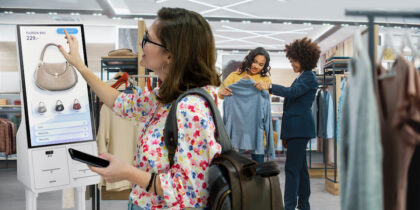Experiential retail experiences, sometimes referred to as “shoppertainment,” are helping retailers attract shoppers to their brick-and-mortar stores by finding ways to make those locations viable even as online retail sales continue to grow.
Despite the spike in online retail sales, a recent Accenture survey reports that 82 percent of millennials actually prefer to shop at physical locations. Therefore, businesses with significant investments in brick-and-mortar locations are turning to creative methods such as shoppertainment to attract these shoppers into their physical spaces.
As ShopperTrak discusses, shoppertainment attracts consumers through interactive and engaging activities. Some are longtime standards such as a visiting Santa Claus during the holidays, while others are permanent exhibits like carousels, or temporary ones such as model trains. But some retailers in malls offering these shoppertainment experiences are still suffering — large businesses like Sears and Macy’s have announced the closing of hundreds of stores. To avoid this fate, retailers are now looking to newer experiential retail experiences that draw on cutting-edge technologies to engage millennials, who have increasing purchasing power and are looking for interactive customer experiences.
Are You Capturing Millennial Shoppers?
Read our eBook for a guide on how to appeal to this growing, digitally-focused group of shoppers. Download Now
New Technologies, New Advantages
To create an interactive customer experience, retailers are using digital signage, virtual mirrors and mobile technologies that interact with customers to make shopping a fun, enjoyable experience rather than a chore.
Digital signage enables businesses to provide engaging messaging inside and outside of the store itself. According to a Nielsen study, four out of five grocers enjoyed increased sales of up to 33 percent of products promoted on digital signage. The Samsung Smart Signage Platform (SSP) provides a streamlined and cost-effective solution to transitioning to digital signage, with an integrated media player built into the display and an open development platform. The integrated media player means it has none of the costs or other issues associated with legacy digital signage solutions. Those legacy systems require additional power, proprietary content management expertise and other additional management costs that Samsung’s SSP doesn’t incur.
Similarly, Samsung mirror displays offer a unique design element for high-end retail spaces. By moving combining a stunning mirror effect and vibrant content, the mirror displays attract and keep customers’ attention. Looking ahead, clothing retailers could leverage smart mirrors in combination with augmented reality software to create an interactive customer experience by enabling shoppers to see how they look in various garments without the need to actually try on the clothes. They could compare items side by side, as well as share the images via smartphones and social media.
In-store kiosks are another way retailers can provide interactive customer experiences, from coupon generation to interactive rewards.
Retailers can also employ mobile solutions such as POS devices and tablets to enable sales associates to engage customers in stores, eliminating frustrating and time-consuming lines at the checkout counter. Armed with tablets, associates can also knowledgeably answer any customer questions, including inventory and option availability, product specs and other details customers want before finalizing their purchases.
The idea behind all of these shoppertainment strategies is to offer consumers new and engaging retail experiences that will not only have them choose one physical store over another, but also to convince customers to return to the store time and time again.
Looking for more innovative ways to bring customers into your stores? Our retail solutions page offers cutting-edge technology to enhance the customer experience and keep your store ahead of the competition.








